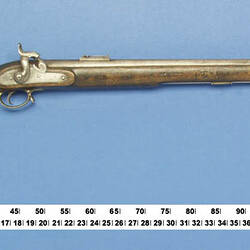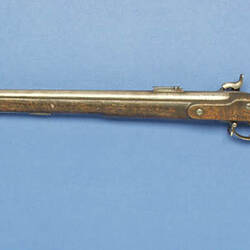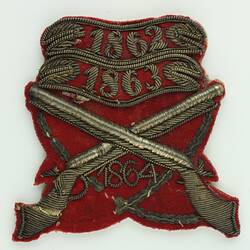Summary
British Service percussion musket, Altered Pattern 1842 Rifle (Sea Service), cal. .758 in., steel rifled (three groove, Minie) round barrel, 762 mm long, with Lovell's bayonet catch on R.H.side.
One of 26 guns donated in 1871 by the Victorian Ordnance Department from its Melbourne Armoury, for the newly created Industrial and Technological Museum. The display was intended to show mechanics and gunsmiths the principles of gun construction and recent technical developments in weapons.
Physical Description
Steel side lock and hammer on R.H. side, brass oval triggerguard with small front spur and longer rear extension, two brass 'Lovell's sidenail cups' for lockplate screws on L.H.side, brass foreend and butt plate on R.H.side, two sling swivels, one mounted from triggerguard, the other above front ramrod tube. Barleycorn foresight, notched leaf rear sight marked to 1000 yards, barrel fastened to stock via two barrel pins, steel ramrod, and two brass ramrod tubes, the front one being trumpet shaped. Lockplate stamped with crown over 'V-R', '1855/ TOWER' and partly obscured 'B/25', probably relating to 25 Bore calibre.
Significance
While the Pattern 1842 Musket was originally a smoothbore, as its name suggests, the Altered Pattern 1842 Sea Service had several marked modifications, the most obvious being the introduction of either 3 or 4 groove Minie rifling. The barrels were reduced from the Pattern 1842's 39" to the Sea Service 30" and the bore was increased in the process of rifling to .758 in. The reduced barrel length meant that only two ramrod tubes were fitted, and unlike the Pattern 1842, the Sea Service variant had the barrel fastened to the stock via pins, rather than barrel keys. Conversion from the Pattern 1842 commenced in 1852 and continued until the introduction of the .577 Naval Rifle in 1857. Victoria had a number of this model on issue between 1861 and 1871, and while no known examples carry specific Victorian markings, several have reserve grade markings, perhaps the rack number '5' on the buttplate tang being one of these.
More Information
-
Collecting Areas
-
Acquisition Information
Donation from Melbourne Armoury, 24 Oct 1871
-
User
Victoria: Ordnance Branch, Melbourne, Greater Melbourne, Victoria, Australia, 1861-1871
-
Inscriptions
Stamped on lockplate: crown over 'VR', 1855/ TOWER, B/ 25 (partly obscured) Stamped on stock underside with ordnance marks Stamped on stock R.H.side: broad arrow over 'BO' (Board of Ordnance) Stamped on barrel with Birmingham government proofmarks Stamped on buttplate tang: 5 (framed in oval)
-
Model Name or Number
-
Brand Names
-
Classification
-
Category
-
Discipline
-
Type of item
-
Overall Dimensions
116.4 cm (Length), 6.3 cm (Width), 19.3 cm (Height)
Barrel length: 76.20cm
-
References
[Book] Penrose, Edgar H. 1949. Descriptive Catalogue of the Collection of Firearms in the Museum of Applied Science of Victoria. 161. 14.
-
Keywords
Rifles & Muskets: British, Rifles & Muskets: Military, Victorian Colonial Defence Forces




